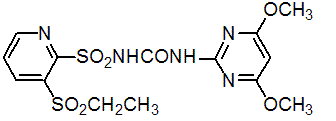RIMSULFURON 玉嘧磺隆, 砜嘧磺隆
Introduction: A herbicide for annual grass and annual broad-leaved weed control in maize and other crops, such as potato; tomato; fruit including citrus, apples, pears, cherries, peaches, apricot, grapes; tree nuts; pistachios.
Common name: Rimsulfuron
Another name: Titus, Matrix, Tarot, etc.
Chemical name: 1-(4,6-dimethoxypyrimidin-2-yl)-3-(3-ethylsulfonyl-2-pyridylsulfonyl)urea
Empirical formula: C14H17N5O7S2
Structural formula:

Mol. Weight: 431.44 g/mol
CAS No.: 122931-48-0
Specifications
Leading Rimsulfuron supplier
Rimsulfuron 25% WDG
Rimsulfuron 95% TC
Packing:
BULK PACKING
Solid: 25kg/Bag, 25kg/Drum, 50kg/Drum etc.
SMALL PACKING
Solid: 1kg/Alu bag, 500g/Alu bag, 200g/Alu bag, 100g/Alu bag, 50g/Alu bag, 15g/Alu bag etc.
Customerized packing label
Rimsulfuron FAO standard
Professional registration
HAZARDS IDENTIFICATION
Hazard statement(s)
H319 (54.1%): Causes serious eye irritation.
H400 (45.9%): Very toxic to aquatic life.
H410 (47.54%): Very toxic to aquatic life with long lasting effects.
Precautionary statement(s)
P264: Wash ... thoroughly after handling.
P273: Avoid release to the environment.
P280: Wear protective gloves/protective clothing/eye protection/face protection.
P305+P351+P338: IF IN EYES: Rinse cautiously with water for several minutes. Remove contact lenses if present and easy to do - continue rinsing.
P337+P313: IF eye irritation persists: Get medical advice/attention.
P391: Collect spillage.
P501: Dispose of contents/container to ...
Supplemental Hazard Statements: none
MAMMALIAN TOXICOLOGY
Acute toxicity: 1) Acute oral LD50 for rat: >5000 a.i.mg/kg. 2) Acute dermal LD50 for rat: >2000 a.i.mg/kg. 3) Inhalation LC50 (4 h) for rat: >5.4 a.i. mg/L. 4) Non-irritating to skin (rabbits). 5) Moderately irritating to eyes (rabbits). 6) Not a skin sensitiser (guinea pigs).
NOEL: (2 y) for male rats is 300, female rats is 3000 ppm; (18 mo) for mice is 2500 ppm; (1 y) for dogs is 50 ppm. NOEL in 2-generation rat reproduction study is 3000 ppm. Not teratogenic or oncogenic. Non-mutagenic in the Ames test.
ADI: 0.1 mg/kg b.w./day [Rat, SF=100]
Classification:
Toxicity class WHO (a.i.): U (Unlikely to present an acute hazard)
US EPA Classification (formulation): III (Caution - Slightly toxic)
EC Risk Classification: N - Dangerous for the environment: R20, R53
ECOTOXICOLOGY
Effect on birds: low toxicity to birds, acute oral LD50 for Bobwhite quail is >2250 a.i.mg/kg. Effect on fish: low toxicity to fish, acute 96 hour LC50 for Rainbow trout is >390 a.i.mg/L. Effect on aquatic invertebrates: low toxicity to aquatic invertebrates, acute 48 hour EC50 for Daphnia magna is >360 a.i.mg/L. Effect on algae: moderate toxicity to algae, acute 72 hour EC50 for Scenedemus subspicatus is 1.2 a.i.mg/L. Effect on honeybees: low-moderate toxicity to honeybees, contact acute 48 hour LD50 is >100 a.i.μg/bee; oral acute 48 hour LD50 is 41.1 a.i.μg/bee. Effect on earthworms: low toxicity to earthworms, acute 14 day LC50 for Eisenia foetida is >1000 a.i.mg/kg.
ENVIRONMENTAL FATE
Rimsulfuron's production may result in its release to the environment through various waste streams; its use as a herbicide will result in its direct release to the environment. If released to air, a vapor pressure of 1.13×10-8 mm Hg at 25 deg C indicates rimsulfuron will exist solely in the particulate phase in the atmosphere. Particulate-phase rimsulfuron will be removed from the atmosphere by wet or dry deposition. Rimsulfuron absorbs light at wavelengths 216 nm, 249 nm, and 298 nm, and therefore may be susceptible to direct photolysis by sunlight. If released to soil, rimsulfuron is expected to have very high to high mobility based upon a Koc range of 13 to 76. Sulfonylurea herbicides, such as rimsulfuron, are more mobile in alkaline soils and in soils with lower organic matter content. The pKa of rimsulfuron is 4.0, indicating that this compound will exist partially in the anion form in the environment and anions generally do not adsorb more strongly to soils containing organic carbon and clay than their neutral counterparts. Volatilization from moist soil surfaces is not expected to be an important fate process based upon an estimated Henry's Law constant of 6.4×10-10 atm-cu m/mole. Rimsulfuron may not volatilize from dry soil surfaces based upon its vapor pressure. Biodegradation half-lives in soil of 24.5 days in the laboratory and 5.7 days under field conditions suggest that biodegradation may be an important environmental fate process in soil and water. If released into water, rimsulfuron is not expected to adsorb to suspended solids and sediment based upon the estimated Koc. Rimsulfuron undergoes hydrolysis in the environment with half-lives ranging from 0.08 to 11.89 days depending on pH and temperature. Volatilization from water surfaces is not expected to be an important fate process based upon this compound's estimated Henry's Law constant. An estimated BCF of 3 suggests the potential for bioconcentration in aquatic organisms is low.
Usage: Herbicide reported by H. L. Palm et al. (Proc. 1989 Br. Crop Prot. Conf. - Weeds, 1, 23). Introduced by E. I. du Pont de Nemours and Co. and first marketed in Europe in 1991. Manufacturers: DuPont. Branched chain amino acid synthesis (ALS or AHAS) inhibitor. Acts by inhibiting biosynthesis of the essential amino acids valine and isoleucine, hence stopping cell division and plant growth. Crop selectivity derives from rapid, selective metabolism by contraction of the sulfonylurea group and ring migration (L. Martinetti et al., Proc. Br. Crop Prot. Conf. - Weeds, 1995, 1, 405) and by hydroxylation on the pyrimidine ring, followed by glucose conjugation (M. K. Koeppe, IUPAC 5E-003 (1998)).
Application: Selective systemic herbicide, absorbed by the foliage and roots, with rapid translocation to the meristematic tissues. Rimsulfuron is a post-emergence sulfonylurea herbicide that effectively controls most annual and perennial grasses and several broad-leaved weeds in maize. Also used in tomatoes and potatoes. The target rate for most situations is 15 g/ha. Rimsulfuron has a wide crop-safety margin under most conditions.
| 






